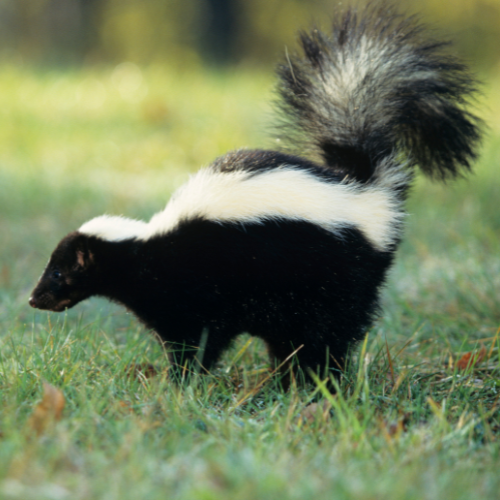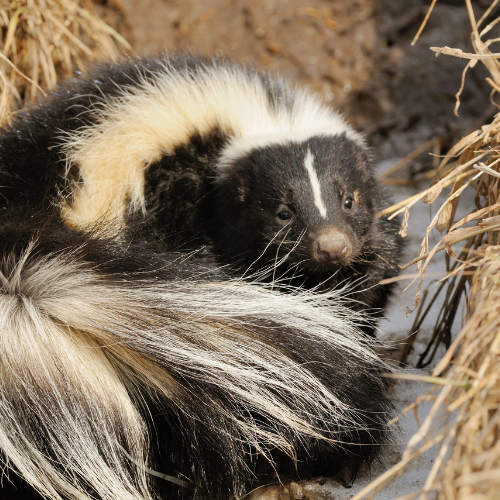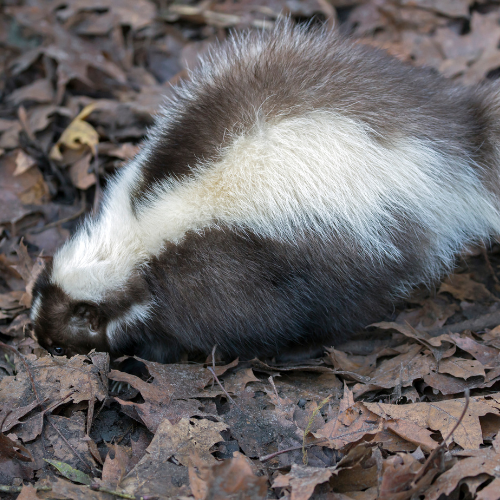Striped Skunk
Introduction to
The striped skunk (Mephitis mephitis) is a well-known mammal native to North America, recognized for its distinctive black and white coloring and its ability to spray a foul-smelling liquid as a defense mechanism. While these nocturnal creatures play a beneficial role in controlling insect and rodent populations, they can become problematic when they take up residence near homes or other human structures. Understanding the biology, habits, and effective prevention methods for striped skunks is crucial for managing their presence and minimizing potential conflicts.
Recognition
Striped skunks are medium-sized mammals, typically measuring 20 to 30 inches in length, including their bushy tails, and weighing between 4 to 10 pounds. They are easily recognized by their black fur with distinctive white stripes that run from the head down the back and tail. Each skunk’s stripe pattern is unique, but they generally have a single stripe on the head that splits into two stripes along the back. Striped skunks have short legs, a small head, and long claws adapted for digging. Unlike similar animals such as raccoons or badgers, skunks have a more streamlined body and a distinctive waddling gait.
Biology
Striped skunks have a lifecycle that includes birth, juvenile, and adult stages. Females give birth once a year, typically in late spring, after a gestation period of about 60 to 75 days. Litters usually consist of 4 to 6 kits, which are born blind and helpless. The kits open their eyes at around three weeks and are weaned by two months. Juvenile skunks stay with their mother until fall, learning to forage and defend themselves. Skunks reach sexual maturity by one year of age. They are omnivorous, feeding on insects, small mammals, birds, eggs, fruits, and plants. Their diet helps control pest populations but can lead them to human food sources, creating conflicts.
Habits
Striped skunks are nocturnal and prefer habitats with a mix of open fields and forested areas, often near water sources. They are versatile and can adapt to urban and suburban environments, making dens in burrows, hollow logs, under buildings, or in abandoned structures. Skunks are solitary animals, except during the breeding season and when females are raising their young. They have a home range of about 1 to 1.5 miles but may travel further in search of food. Skunks are known for their defensive spray, a sulfur-based compound that can cause temporary blindness and severe irritation.
Prevention
Preventing skunk infestations involves removing attractants and securing potential den sites. Keep garbage cans tightly sealed and avoid leaving pet food or birdseed outside. Store food and compost in secure containers. Remove brush piles, woodpiles, and other debris that could provide shelter. Seal openings under decks, porches, and sheds with sturdy mesh or hardware cloth. Use motion-activated lights or sprinklers to deter skunks from entering your yard. If skunks have already taken up residence, consider using skunk repellents or contacting a professional for humane removal.
Professional
If skunks become a persistent problem, professional pest control services can provide effective solutions. STL Pest Control offers comprehensive treatments to manage skunk populations and protect your property. Their technicians are trained to identify skunk burrows and apply appropriate control methods, including trapping and exclusion. In severe cases, they may recommend ongoing maintenance plans to keep skunk populations under control. Professional services ensure thorough and humane control, providing peace of mind and a safer living environment.



Our Office









